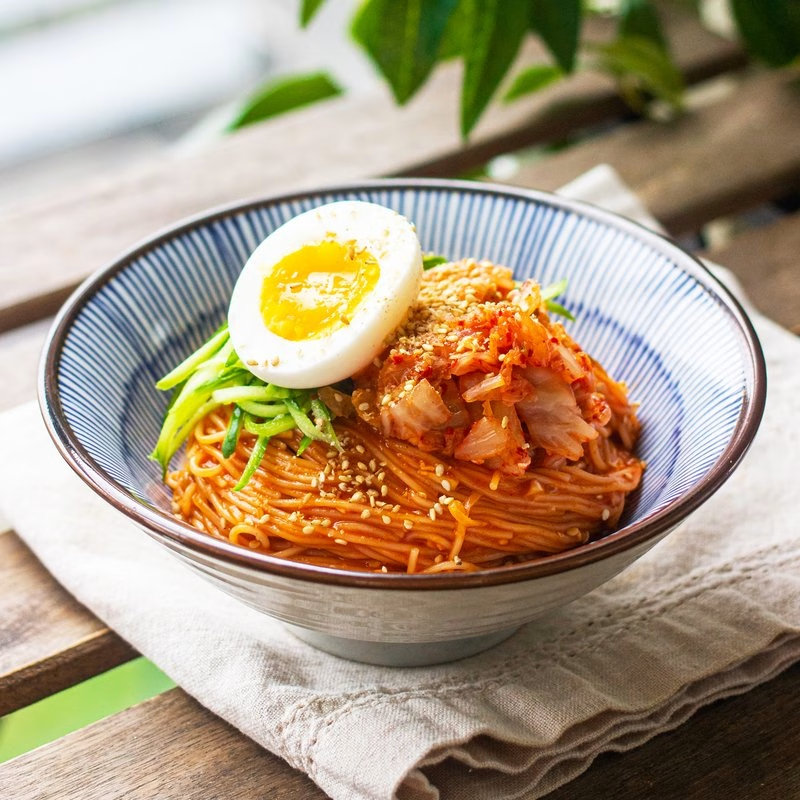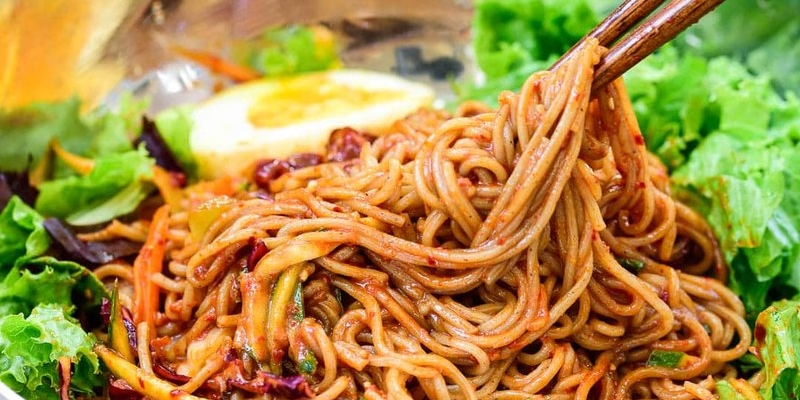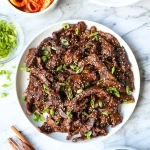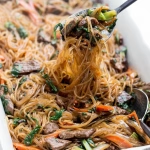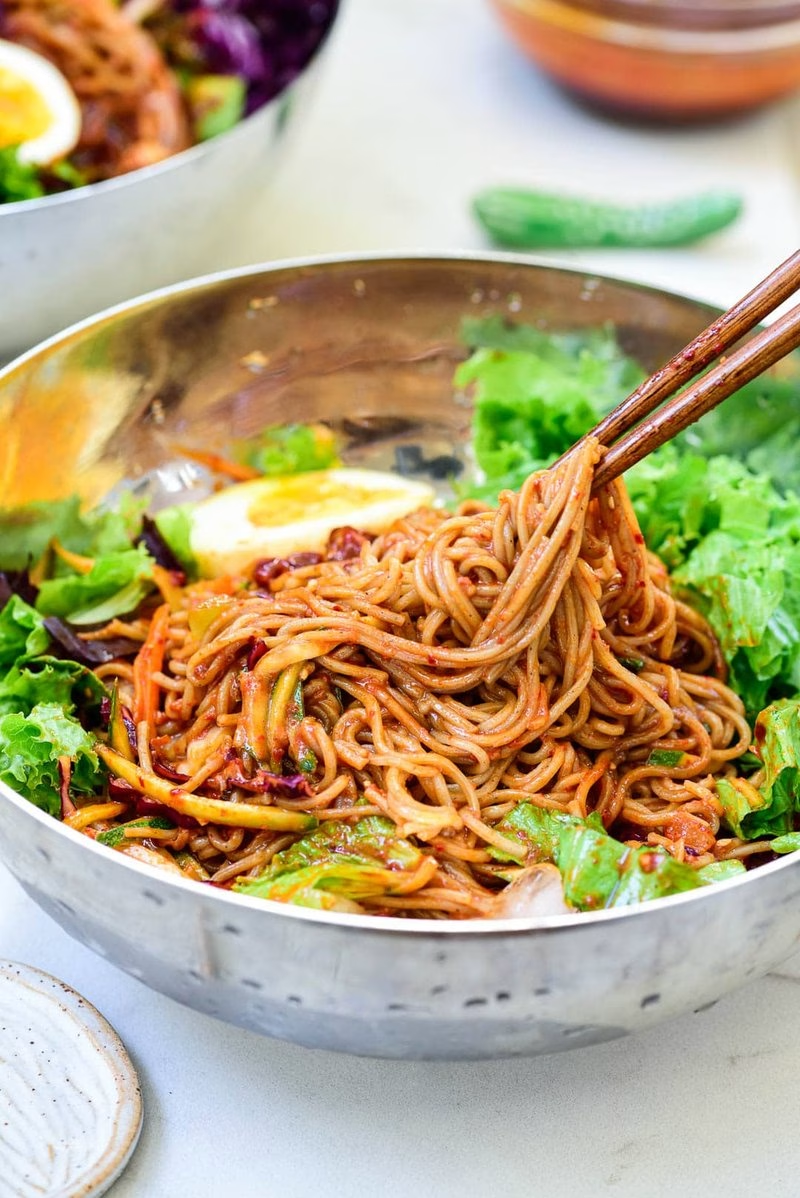
Introduction
Bibim Noodles, also known as Bibim Guksu, is a vibrant Korean dish that packs a punch with its delightful mix of flavors and textures. It’s a cold noodle dish perfect for hot summer days or any time you crave something refreshing yet satisfying. With roots in traditional Korean cuisine, Bibim Noodles are cherished for their variety and versatility, allowing countless adaptations to suit all tastes.
You might be wondering what makes Bibim Noodles so special. The combination of chewy noodles, seasonal vegetables, and a spicy-sweet sauce creates an unforgettable experience that dances on your palate. In this article, we’ll dive into the nitty-gritty of how to make Bibim Noodles at home, explore different Bibim Noodles variations, and share key tips for elevating your dish to restaurant-quality perfection.
So, grab your apron and get ready to make your taste buds tingle!
Ingredients
Here’s what you’ll need to whip up delicious Bibim Noodles at home.
| Ingredient | Amount | Description |
|---|---|---|
| Cold buckwheat noodles | 200g | These chewy noodles serve as the perfect base for your Bibim Noodles. |
| Cucumber | 1, julienned | Fresh cucumber adds a refreshing crunch and is a classic topping. |
| Carrot | 1, julienned | Carrots bring sweetness and color, complementing the dish beautifully. |
| Red bell pepper | 1, sliced | This adds vibrancy and a hint of sweetness to the mix. |
| Green onions | 2, chopped | They enhance the dish with a mild onion flavor and freshness. |
| Sesame oil | 2 tbsp | A drizzle of sesame oil provides a nutty aroma to the noodles. |
| Korean Gochujang (chili paste) | 1 tbsp | This fermented chili paste adds a spicy kick that is unmistakably Korean. |
| Soy sauce | 1 tbsp | Brings umami richness to balance the dish while enhancing the vegetables. |
| Vinegar | 1 tbsp | Adds tanginess to the sauce for a perfect flavor contrast. |
| Sesame seeds | 1 tbsp | Toasted sesame seeds are perfect for adding a bit of crunch and flavor. |
Step-by-Step Instructions
Making Bibim Noodles is easier than you might think! Here’s how to do it:
- Step 1: Prepare the Ingredients – Start by cooking the cold buckwheat noodles according to package instructions. Once cooked, rinse them thoroughly under cold water until completely cool. This step gives them that wonderful chewy texture characteristic of great Bibim Noodles.
- Step 2: Make the Sauce – In a small bowl, combine Korean Gochujang, soy sauce, vinegar, and sesame oil. Mix well until smooth. This sauce should be spicy, tangy, and just a bit sweet. Feel free to adjust the Gochujang amount to suit your spice tolerance!
- Step 3: Chop the Veggies – Julienne the cucumber and carrot, and slice the red bell pepper. Chop the green onions. Each vegetable not only adds beautiful color but also contributes unique textures and flavors to your Bibim Noodles.
- Step 4: Toss Everything Together – In a large mixing bowl, combine the cooled noodles with the prepared sauce. Add in the chopped vegetables and toss well until everything is evenly coated. Aim for that beautiful rainbow effect!
- Step 5: Serve and Garnish – Divide the Bibim Noodles into bowls and sprinkle with sesame seeds and more green onions. For extra flair, you can add a hard-boiled egg on top. Serve immediately, and watch everyone devour your masterpiece!
Pro Tips
– **Use fresh ingredients**: The quality of vegetables will greatly enhance the flavor and texture of your Bibim Noodles. Fresh, crisp veggies will add crunch and vibrancy.
– **Customize your sauce**: Adjust the spiciness of the Gochujang to fit your palate. If you’re not a fan of heat, reduce the amount, or try using a milder chili paste.
– **Add protein**: For a heartier meal, throw in sliced grilled chicken, beef, or tofu. This addition makes it more filling while providing extra flavor.
– **Chill the noodles**: For the best results, allow your noodles to chill in the refrigerator for a bit before serving. This adds to the refreshing quality of the dish.
– **Experiment with toppings**: You can customize this dish with toppings like sliced cucumbers, boiled eggs, or even kimchi for an extra punch of flavor!
Nutritional Information
Here’s a quick look at the nutritional content per serving of Bibim Noodles:
| Nutritional Component | Per Serving |
|---|---|
| Calories | 350 |
| Protein | 10g |
| Carbohydrates | 50g |
| Saturated Fats | 1g |
| Fiber | 5g |
| Cholesterol | 0mg |
| Sugars | 5g |
| Fat | 10g |
FAQs
What is the best way to store Bibim Noodles?
Store any leftovers in an airtight container in the fridge for up to 2 days. The noodles may soak up some sauce, but they’ll still be delicious!
Can Bibim Noodles be made vegan or gluten-free?
Absolutely! Use gluten-free noodles like rice noodles or zucchini noodles, and replace any animal-based ingredients with tofu or more veggies for a vegan-friendly option.
What are the best side dishes to serve with Bibim Noodles?
Bibim Noodles pair wonderfully with kimchi, pickled vegetables, or a light soup to balance the meal.
How long does it take to prepare Bibim Noodles?
From start to finish, this dish takes about 30 minutes, making it a quick and easy option for a weeknight meal.
Can I freeze Bibim Noodles for later?
It’s not recommended to freeze the noodles as they may become mushy when thawed. Instead, enjoy it fresh or store leftovers in the fridge.
What makes Bibim Noodles unique?
The combination of spicy gochujang, fresh veggies, and cold noodles creates a refreshing dish that contrasts the hot weather while delivering a flavor explosion.
Is Bibim Noodles suitable for a low-calorie diet?
You can enjoy Bibim Noodles as part of a balanced diet. Adjust the portion size and keep the ingredients fresh for a healthier option.
Can I get creative with the toppings on my Bibim Noodles?
Absolutely! From shredded cabbage to avocado slices and toasted nuts, feel free to go wild with your toppings!
In summary, **Bibim Noodles** is a delightful dish that captures the essence of Korean cuisine in every bite. Whether you’re a long-time fan or trying it for the first time, the combination of fresh vegetables, chewy noodles, and spicy sauce is sure to impress. So, gather your ingredients, follow these easy steps, and enjoy the creativity of cooking.
Ready to whip up this vibrant dish? *Tried this Bibim Noodles recipe? Let us know your experience in the comments!*
